Libya's history covers its rich mix of ethnic groups added to the indigenous Berbers/Amazigh people. Amazigh have been present throughout the entire history of the country. For most of its history, Libya has been subjected to varying degrees of scholar control, from Europe, Asia, and Africa. The modern history of independent Libya, as reflected in the many revolutions denoted under many moons began before Romantic time or Justinian scribing.

The Italo-Turkish or Turco-Italian War was fought between the Kingdom of Italy and the Ottoman Empire from September 29, 1911, to October 18, 1912. As a result of this conflict, Italy captured the Ottoman Tripolitania Vilayet (province), of which the main sub-provinces (sanjaks) were Fezzan, Cyrenaica, and Tripoli itself. These territories became the colonies of Italian Tripolitania and Cyrenaica, which would later merge into Italian Libya.

Tripolitania is a historic region and former province of Libya.
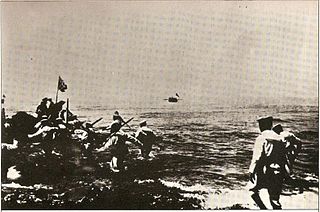
The Invasion of Libya by Italy happened in 1911, when Italian troops invaded the Turkish province of Libya and started the Italo-Turkish War. As result, Italian Tripolitania and Italian Cyrenaica were established, later unified in the colony of Italian Libya.
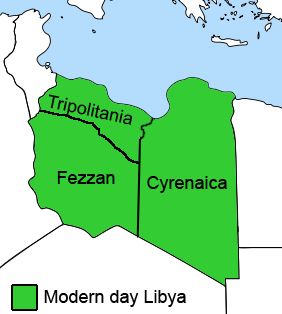
Subdivisions of Libya have varied significantly over the last two centuries. Initially Libya under Ottoman and Italian control was organized into three to four provinces, then into three governorates (muhafazah) and after World War II into twenty-five districts (baladiyah). Successively into thirty-two districts (shabiyat) with three administrative regions, and then into twenty-two districts (shabiyat). In 2012 the ruling General National Congress divided the country into governorates (muhafazat) and districts (baladiyat). While the districts have been created, the governorates have not.

The coastal region of what is today Libya was ruled by the Ottoman Empire from 1551 to 1912, first, from 1551 to 1864, as the Eyalet of Tripolitania or Bey and Subjects of Tripoli of Barbary, later, from 1864 to 1912, as the Vilayet of Tripolitania. It was also known as the Kingdom of Tripoli, even though it was not technically a kingdom, but an Ottoman province ruled by pashas (governors). The Karamanli dynasty ruled the province as de facto hereditary monarchs from 1711 to 1835, despite remaining under nominal Ottoman rule and suzerainty from Constantinople.

Italian colonizationof Libya began in 1911 and lasted until 1943. The country, previously an Ottoman possession, was occupied by Italy in 1911 after the Italo-Turkish War, which resulted in the establishment of two colonies: Italian Tripolitania and Italian Cyrenaica. In 1934, they were unified in the colony of Italian Libya. In 1937 this colony was divided into four provinces, and in 1939 the coastal provinces became part of metropolitan Italy. The colonization lasted until Libya's occupation by Allied forces in 1943, though it was not until the 1947 Paris Peace Treaty that Italy officially renounced all claims to Libyan territory.

Pasha of Tripoli was a title that was held by many rulers of Tripoli in Ottoman Tripolitania. The Ottoman Empire ruled the territory for most time from the Siege of Tripoli in 1551 until the Italian invasion of Libya in 1911, at the onset of the Italo-Turkish War.
The military history of Libya covers the period from the ancient era to the modern age.

Italian Libya was a colony of the Kingdom of Italy located in North Africa, in what is now modern Libya, between 1934 and 1943. It was formed from the Italian colonies of Cyrenaica and Tripolitania that were taken by Italy from the Ottoman Empire in the Italo-Turkish War of 1911 to 1912. They were unified in 1934 by governor Italo Balbo, with Tripoli as the capital.

Italian Tripolitania was an Italian colony, located in present-day western Libya, that existed from 1911 to 1934. It was part of the territory conquered from the Ottoman Empire after the Italo-Turkish War in 1911. Italian Tripolitania included the western northern half of Libya, with Tripoli as its main city. In 1934, it was unified with Cyrenaica in the colony of Italian Libya.

Italian Cyrenaica was an Italian colony, located in present-day eastern Libya, that existed from 1911 to 1934. It was part of the territory conquered from the Ottoman Empire during the Italo-Turkish War of 1911, alongside Italian Tripolitania.
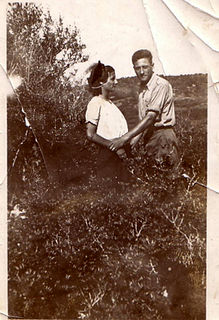
Italian settlers in Libya typically refers to Italians, and their descendants, who resided or were born in Libya during the Italian colonial period.
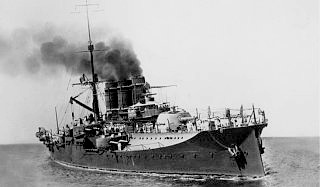
Napoli was a Regina Elena-class pre-dreadnought battleship built for the Italian Regia Marina in 1903–08. She was the last member of the four-ship class, which included the lead ship Regina Elena, Vittorio Emanuele, and Roma. Napoli was armed with a main battery of two 12-inch (305 mm) and twelve 8 in (203 mm) guns, and was capable of a top speed of 21 knots.

Liguria was a protected cruiser built for the Italian Regia Marina. She was the fourth of six Regioni-class cruisers, all of which were named for regions of Italy. Liguria was built by the Ansaldo shipyard in Genoa; her keel was laid in July 1889, she was launched in June 1893, and was commissioned into the fleet in December 1894. The ship was equipped with a main armament of four 15 cm (5.9 in) and six 12 cm (4.7 in) guns, and she could steam at a speed of 18 knots.
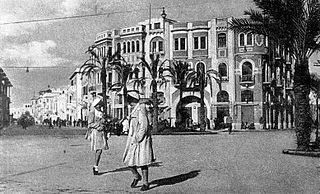
Italian Benghazi was the name used during the Italian colonization of Libya for the port-city of Benghazi in Italian Cyrenaica.
Events from the year 1911 in Italy.
The following is a timeline of the history of the city of Benghazi, Libya.

The Battle of Ain Zara was fought in December 1911 during the Italo-Turkish War between the Kingdom of Italy and Ottoman Empire forces for the control of the oasis of Ain Zara, near Tripoli in modern Libya, where the Ottomans had established a fortified base.
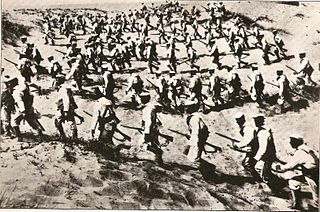
The Battle of Tripoli was fought in October 1911, during the initial stages of the Italo-Turkish War, and saw the capture of Tripoli, capital city of Tripolitania, by Italian landing forces. It marked the beginning of the land campaign in Libya of the Italo-Turkish War as well as the beginning of the Italian colonization of Libya.














